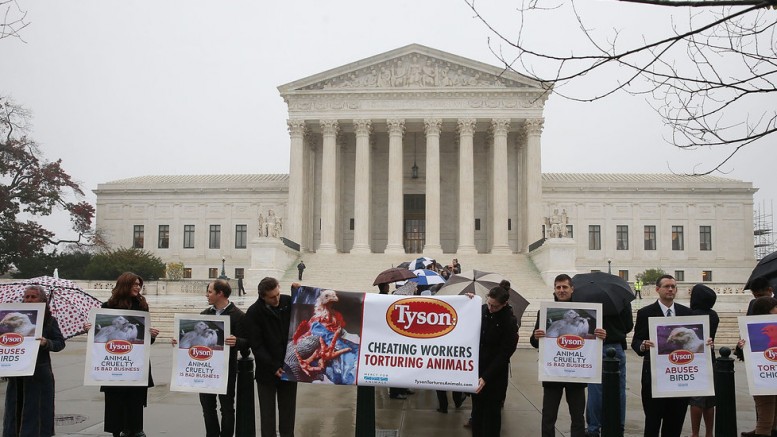
WASHINGTON — The Supreme Court on Tuesday sided with thousands of workers at an Iowa pork processing plant who had sought to band together in a single lawsuit to recover overtime pay from Tyson Foods.
Justice Anthony M. Kennedy, writing for the majority in the 6-to-2 decision, said the plaintiffs were entitled to rely on statistics to prove their case. The ruling limited the sweep of the court’s 2011 decision in Walmart Stores v. Dukes, which threw out an enormous employment discrimination class-action suit and made it harder for workers, investors and consumers to join together to pursue their claims.
The Tyson workers performed tasks that were “grueling and dangerous” at a plant in Storm Lake, Iowa, Justice Kennedy wrote, slaughtering hogs, trimming the meat and preparing it for shipment. They sought to be paid for the time they had spent putting on and taking off protective gear to prevent knife cuts.
Tyson did not keep records, and the workers tried to prove their damages based on an expert witness’s statistical inferences from hundreds of videotaped observations of how long it took the workers to get ready.
The company objected, saying there was wide variation in how long the extra work took and that some workers were not entitled to overtime at all.
But Justice Kennedy said statistical proof was sufficient.
“A representative or statistical sample, like all evidence, is a means to establish or defend against liability,” he wrote. “Its permissibility turns not on the form a proceeding takes — be it a class or individual action — but on the degree to which the evidence is reliable in proving or disproving the elements of the relevant cause of action.”
The Walmart decision did not help Tyson, Justice Kennedy wrote.
“Walmart does not stand for the broad proposition that a representative sample is an impermissible means of establishing classwide liability,” he said, adding: “While the experiences of the employees in Walmart bore little relationship to one another, in this case each employee worked in the same facility, did similar work, and was paid under the same policy.”
The workers should not suffer because Tyson failed to keep records, Justice Kennedy added, citing a 1946 precedent, Anderson v. Mt. Clemens Pottery. “Where the employer’s records are inaccurate or inadequate and the employee cannot offer convincing substitutes,” the court said in 1946, it is enough for workers to rely on “sufficient evidence to show the amount and extent of that work as a matter of just and reasonable inference.”
In dissent, Justice Clarence Thomas, joined by Justice Samuel A. Alito Jr., said that approach “puts employers to an untenable choice.”
“They must either track any time that might be the subject of an innovative lawsuit,” Justice Thomas wrote, “or they must defend class actions against representative evidence that unfairly homogenizes an individual issue.”
Justice Thomas added that the Walmart decision, rejecting evidence from about 120 women to show discrimination against 1.5 million employees, required a ruling against the Tyson workers.
“Just as individual managers inherently make discretionary decisions differently, so too do individual employees inherently spend different amounts of time donning and doffing” protective gear, he wrote. “And, just as 120 employee anecdotes could not establish that all 1.5 million class members faced discrimination, neither can” the Tyson workers’ evidence “establish that all 3,344 class members spent the same amount of time donning and doffing.”
The workers in the case, Tyson Foods v. Bouaphakeo, No. 14-1146, had won about $6 million. The money has not yet been distributed, and Justice Kennedy said the company remained free to challenge payments to workers who were not eligible for overtime.
In a concurrence, Chief Justice John G. Roberts Jr. said that allocating the money could prove impossible. “If there is no way to ensure that the jury’s damages award goes only to injured class members, that award cannot stand,” he wrote.
The decision was the second victory for plaintiffs in the three class-action cases the court has heard this term. In January, in Campbell-Ewald Co. v. Gomez, No. 14-857, the Supreme Court on Wednesday ruled by a 6-to-3 vote that courts could not dismiss lawsuits simply because a defendant had offered to give the lead plaintiff everything he sought.
A third, Spokeo v. Robins, No. 13-1339, is yet to be decided. It asks whether Congress may authorize lawsuits by plaintiffs who cannot prove they suffered a concrete injury.
In a second development on Tuesday, the court said it had split 4-to-4 in Hawkins v. Community Bank of Raymore, No. 14-520. It was the first such tie vote since the death last month of Justice Antonin Scalia. The case was argued in October, and it had probably been headed for a 5-to-4 ruling with Justice Scalia in the majority.
Tuesday’s unsigned ruling, saying only that “the judgment is affirmed by an equally divided court,” left in place an appeals court decision siding with a bank in a dispute over whether it could enforce a spouse’s loan guarantee.
Based on Justice Scalia’s questions at the argument in October, he was inclined to support the bank’s position, meaning it would have won the case either way. But the Supreme Court’s tie vote established no national precedent, and it left unresolved a legal question that had divided federal appeals courts.
Follow The New York Times’s politics and Washington coverage on Facebook and Twitter, and sign up for the First Draft politics newsletter.
A version of this article appears in print on March 23, 2016, on page B2 of the New York edition with the headline: Supreme Court Upholds Workers’ Class-Action Suit Against Tyson Over Pay. Order Reprints| Today’s Paper|Subscribe
Source: www.nytimes.com




